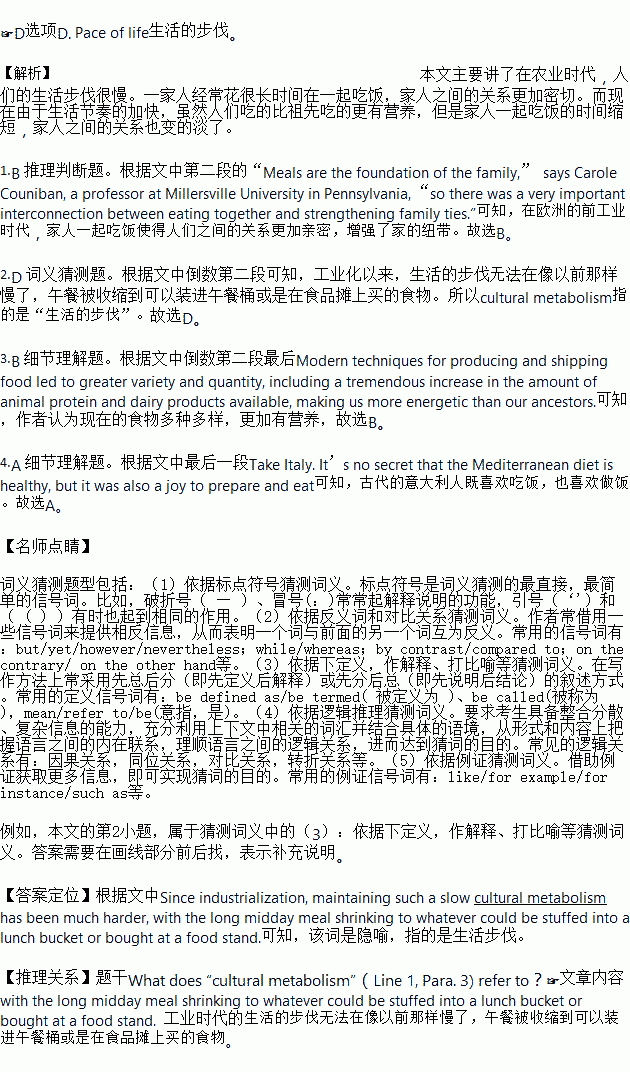题目内容
In agrarian(农业的), pre-industrial Europe, “you’d want to wake up early, start working with the sunrise, have a break to have the largest meal, and then you’d go back to work,” says Ken Albala, a professor of history at the University of the Pacific. “Later, at 5 or 6, you’d have a smaller supper.”
This comfortable cycle, in which the rhythms of the day helped shape the rhythms of the meals, gave rise to the custom of the large midday meal, eaten with the extended family. “Meals are the foundation of the family,” says Carole Couniban, a professor at Millersville University in Pennsylvania, “so there was a very important interconnection between eating together and strengthening family ties.”
Since industrialization, maintaining such a slow cultural metabolism has been much harder, with the long midday meal shrinking to whatever could be stuffed into a lunch bucket or bought at a food stand. Certainly, there were benefits. Modern techniques for producing and shipping food led to greater variety and quantity, including a tremendous increase in the amount of animal protein and dairy products available, making us more energetic than our ancestors.
Yet plenty has been lost too, even in cultures that still live to eat. Take Italy. It’s no secret that the Mediterranean diet is healthy, but it was also a joy to prepare and eat. Italians, says Counihan, traditionally began the day with a small meal. The big meal came at around 1 p.m. In between the midday meal and a late, smaller dinner came a small snack. Today, when time zones have less and less meaning, there is little tolerance for offices’ closing for lunch, and worsening traffic in cities means workers can’t make it home and back fast enough anyway. So the formerly small supper after sundown becomes the big meal of the day, the only one at which the family has a chance to get together. “The evening meal carries the full burden that used to be spread over two meals,” says Counihan.
1.What does Professor Carole Counihan say about pre-industrial European families eating meals together?
A. It was helpful to maintaining a nation’s tradition.
B. It brought family members closer to each other.
C. It was characteristic of the agrarian culture.
D. It enabled families to save a lot of money.
2.What does “cultural metabolism”(Line 1, Para. 3) refer to?
A. Evolutionary adaptation. B. Changes in lifestyle.
C. Social progress. D. Pace of life.
3.What does the author think of the food people eat today?
A. Its quality is usually guaranteed.
B. It is varied, abundant and nutritious.
C. It is more costly than what our ancestors ate.
D. Its production depends too much on technology.
4.What does the author say about Italians of the old days?
A. They enjoyed cooking as well as eating.
B. They ate a big dinner late in the evening.
C. They ate three meals regularly every day.
D. They were expert at cooking meals.
Sadly,no major Australian newspaper or expert commented.This made me aware that Australians are reluctant to face Australia's painful new geopolitical realities.
Against this background,the release of the Asian Century White Paper is timely.It should provide a sharp wake-up call to the Australian population that Australia's destiny(命运)is now firmly tied to Asia.Julia Gillard is right in saying,"The transformation of the Asian region into the economic powerhouse of the world is not only unstoppable,it is gathering pace."
One truly impressive part of the paper is the data it provides on Asia's rise.It notes,for example,that"in the past 20 years,China and India have almost tripled(增三倍)their share of the global economy and increased their economic size almost six times over.By 2025,the region as a whole will account for almost half the world's output."
In this Asian century,as Western power gets weak steadily,Australia will be left"beached"alone as the only Western country (together with New Zealand) in Asia.Twenty-two million Australians will have to learn to deal with 3.5 billion Asians with great care and sensitivity.
Ignorance(无知)about Asia could prove to be fatal(致命的)for Australia's long-term future.This is why the report is right in focusing on Australian misunderstanding of Asia.
Sadly,this kind of terrible ignorance may be a result of Australian education.The report says,"Only a small proportion of Year 12 students study anything about Asia in the subjects of history,literature,geography,economics,politics and the arts under existing state-based curriculums."Worse,only 5 per cent of each Australian groups study any kind of Asian language.
Learning Asian languages would open windows to Asian cultural and political sensitivities.The time for Australians to think deeply about their Asian destiny has arrived.The sooner Australia adjusts to its new Asian destiny,the less painful the adjustment will prove to be.
| Title:It's (66)timeto accept our place in Asian region | |
| (67)Background | (68)Geographicallyspeaking,Australia is close to Asia,yet few Australians are willing to face Australia's new geopolitical (69)realities. |
| Release of the white paper | Aim:To tell Australians that their (70)destinydefinitely has much to do with Asia. Cause:Asia has (71)become the economic powerhouse of the world. (72)Data:China and India have tripled their share of the global economy and the region will account for half the world's output by 2025. |
| Writer's opinions | Australians will be lonely if they don't learn to deal with 3.5 billion Asians. Australian (73)education,in part,is responsible for their ignorance about Asia. It's right for the paper to (74)focuson Australian misunderstanding of Asia. It's high time that Asia languages were (75)taught to Australian children. |
-Just his luck.________.( )
| A. | He has to kill the fatted calf. | |
| B. | He has to face the music. | |
| C. | He must see the handwriting on the wall. | |
| D. | He must be a black sheep. |

